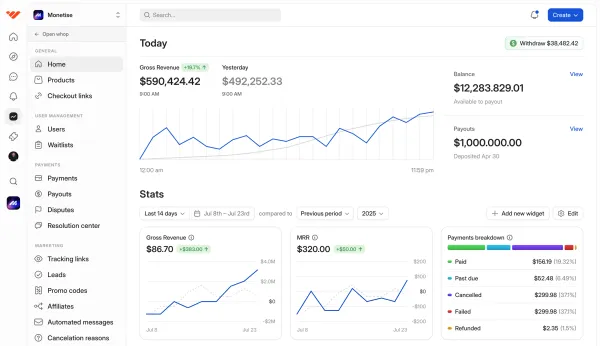Making money online is real. Here's how creators are hitting $1M with digital products, communities, and services.
Key takeaways
- Making $1 million breaks down to $83K monthly or $2,740 daily in achievable chunks.
- Digital products offer infinite margins with zero inventory by packaging solutions once.
- Paid communities monetize proximity and access rather than just content creation.
- Short-form content clipping generates $1K-$20K monthly without requiring large followings.
- Building audiences enables multiple income streams through various monetization methods.
Tommy Richman nailed it when he said “'Cause I wanna make it so badly, I'm a million-dollar baby – don't @ me”. Like, I felt that.
Pretty sure you do too: a recent study saw that Gen Z respondents, on average, believe a net worth of over $9 million is necessary to achieve financial success.
So, how are we getting there?
Making a million used to mean climbing the corporate ladder for decades (no thank you), or hitting the lottery jackpot (hardly a strategy). Now? It’s all about getting smart, getting fast, and owning the online game.
Internet money flipped the script. Today’s millionaires hustle digitally, creating, selling, flipping, and scaling right from their bedroom.
This guide breaks down the real, modern, and no-fluff ways people are hitting that million-dollar mark.
Spoiler: it’s not about luck; it’s about strategy and consistency.
Reality check: What making a million actually looks like
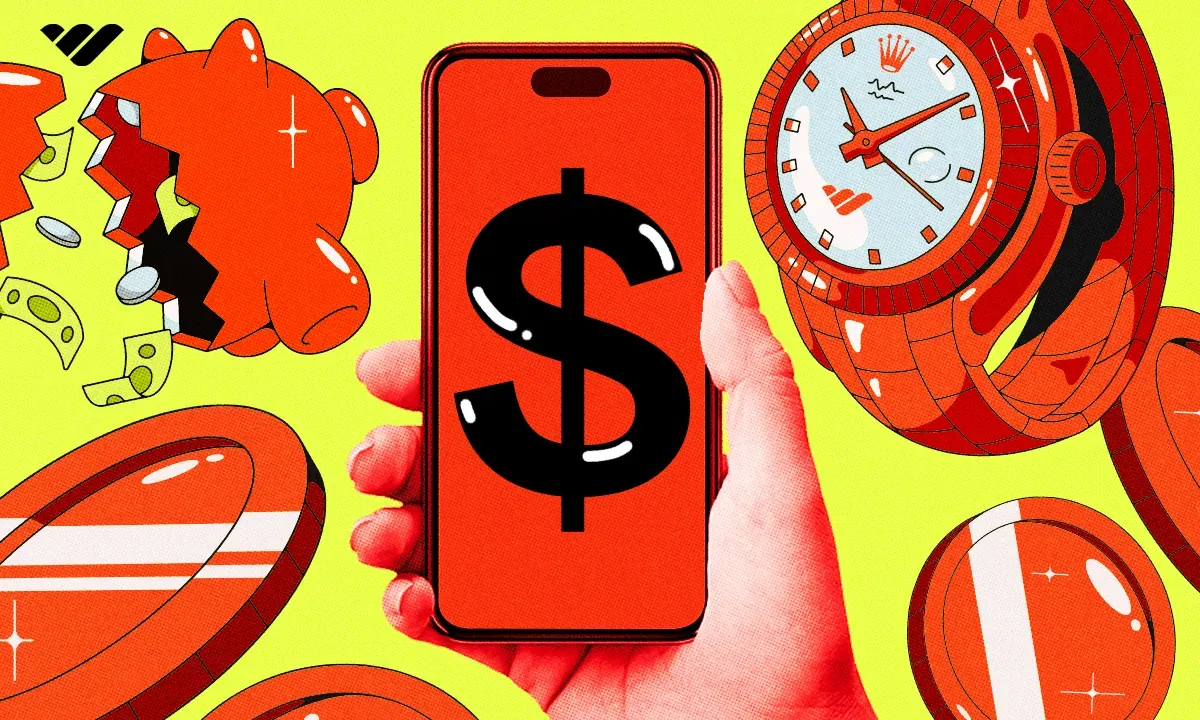
A million dollars in a year sounds massive… until you realize it breaks down to about $83K a month, $19K a week, or $2,740 a day. That’s the real math.
That’s what you’re up against. Not a lottery win. Not one viral moment. Just repeated value, sold over and over again. And that's if you're aiming for a million in a year. You could be aiming for a milly in 3, 5, even 10 years.
Guys, the internet made this doable. It broke the rules – you no longer need to trade time for money.
You don’t have to beg a boss for a raise or wait for someone to “discover” you (cringe).
Now, you can build once and sell forever. You can stack digital products, run a paid community, launch a tool, or drop content that prints money in your sleep.
“[I made my first million] consulting as a solopreneur. Didn’t even realize when I passed 1 million because I was so busy.” - 7thpixel, Reddit
You just need a skill, a product, and a platform that lets you move fast – and you’re a step ahead, because you’re already on that platform.
Success today isn’t about being loud. It’s about being consistent. It’s not the one-hit wonders that win. It’s the people who show up daily, ship work weekly, and treat the process like a sport.
The grind isn’t sexy, but damn, the results are.
Let’s get into how they did it.
10 ways people are making their first million online
Let’s be serious for a minute: nobody's hitting a milly based on vibes. But they are hitting seven figures doing stuff that didn’t exist ten years ago. Digital products, niche communities, UGC, SaaS tools – the list goes on.
Here’s how real people are making real money. Not ‘one day’ money, more like ‘within 5 years’ money.
1. Build and sell digital products
It’s the gateway hustle. You make something once – a Notion template, a workout plan, a trading spreadsheet – and you sell it a thousand times.
Infinite margin. No inventory. No meetings. Just cold, beautiful, passive-ish income.
People think digital products are just for coders. Wrong. They’re for anyone who’s solved a problem and knows how to package it.
How to start: Turn a process, template, or tool you already use into something others can download. Host it on Whop, slap on a clean sales page, and post content around it.
Investment cost: $0 to $200, depending on design/software.
Earning potential: $1K-$20K+/month once you dial in product-market fit. Top sellers push $100K+/year with a few bangers.
How to sell digital products: A step-by-step guide
2. Launch an info product (course, ebook, mentorship)
If you’ve got a skill or specific knowledge and a mic, congrats, you’re ready to monetize.
Info products aren’t dead. Bad ones are.
But niche, high-signal courses still slap, especially if they solve a problem fast.
Think:
- $97 ebook that teaches photographers how to get higher-paying clients
- $300 course on booking voiceover gigs from your bedroom
- $1,000 mentorship for agency owners scaling to $10K/month
Whop lets you sell your info products directly, run limited launches, or bundle them with subscriptions. No excuses.
How to start: Pick one problem you can solve better than Google. Write the solution, record it, or structure it into a short format. Keep it simple. Upload to Whop.
Investment cost: $0 to $500, depending on recording gear or tools. You can start with a Canva slide deck and Loom.
Earning potential: $10K-$50K/launch for niche audiences. With a funnel, $100K+/year is doable.
What are info products? A complete guide (with examples)
3. Start a paid community
This one’s exploding. Creators are ditching the algorithm and building private worlds where their real fans can hang out with other like-minded people.
You’re not selling content, you’re selling proximity. To you, your ideas, your network, your vibe.
That’s why it works.
Communities are low-cost, high-trust, and high-leverage. You don’t need thousands of members. You need the right hundred.
How to start: Set up a paid whop, figure out your value hook (access, calls, exclusivity, resources), market on your social media, Reddit, Discord, etc.
Investment cost: Under $100 to start
Earning potential: $1K/month to $100K+/year. Depends on how many members you attract and retain.
Mastering community management: How to build and manage a thriving online space
4. Sell specialized services
If you’ve got a skill, you’ve got a sellable service.
Whether it’s web design, ad copy, TikTok editing, or landing page audits, the game isn’t about offering everything – it’s about offering something specific.
Buyers want clarity. A clean offer like “I’ll optimize your landing page for conversions in 48 hours” is more valuable than a generic “I do web stuff.”
A lot of creators start solo, get some wins under their belt, and then turn their service into a productized offer with fixed pricing.
Whop makes it easy to package those services as one-click purchases, so you're not stuck chasing invoices – or explaining what you do ten times a week (I feel your pain).
How to start: Choose one skill you’re already good at. Package it into a fixed offer with a clear outcome, and list it on Whop with a simple storefront.
Investment cost: Between $0 and $300, depending on whether you need a site, software, or a demo portfolio.
Earning potential: $3,000 to $30,000 per month, depending on the service, niche, and whether you scale with a team.
5. Clipping and UGC
Short-form content is the currency of the internet right now, and brands are desperate for anyone who knows how to make it. That’s where you come in.
Clipping is all about turning long videos ( like podcasts or YouTube vids) into viral TikToks, X posts, or Reels. UGC (user-generated content) is about filming brand promos that feel organic and not like an ad.
Neither one requires a big following. You just need editing skills, taste, and the ability to package yourself well.
Whop creators have built entire editing agencies starting from their bedrooms, charging retainers instead of one-off gigs. The smart ones template their offer and scale with help.
How to start: Learn how to edit short-form video (like, literally even using CapCut is enough), sign up for Whop to access content rewards, reach out to brands and creators you like directly.
Investment cost: Free.
Earning potential: $1,000 to $20,000 per month, all solo.
6. Flip apps, domains, or SaaS tools
Digital flipping is one of the most underrated ways to hit six figures, fast.
Instead of building from scratch, you buy an underperforming app, domain, or tool, clean it up, give it distribution, and either resell it or monetize it directly.
It’s internet real estate, and the upside is wild if you know what to look for.
Some creators are building microtools in a weekend and flipping them for five figures. Others buy low on sites like MicroAcquire, do a redesign, and relist for triple.
You don’t need to be a dev, you just need to know how to spot potential and sell the story.
How to start: Research small, neglected digital products with upside. Improve them, and list them for resale or recurring revenue through a platform like Whop.
Investment cost: $500 to $5,000+, depending on what you buy and whether you outsource improvements.
Earning potential: $5,000 to $100,000+ per flip. Stack a few and you’re easily into the six-figure zone.
7. Sell subscriptions
The best income is recurring. Whether it’s access to tools, templates, signals, drops, or exclusive content, people will pay to stay in the loop, as long as the value keeps coming.
The key is to keep it lean. You don’t need to build the next Netflix. You just need something useful that people want on a regular basis.
Start with one tight offer, price it smart, and deliver it through Whop, which allows you to price subscription-based access. From there, you can upsell, bundle, and build real MRR.
How to start: Pick a deliverable people want on a regular basis, set a monthly or annual price, and use Whop to handle the rest.
Investment cost: Usually under $100 if you already have content or resources to share.
Earning potential: $1,000 to $50,000 per month, depending on size, churn, and pricing. At scale, it becomes a million-dollar engine.
8. Trading and financial education
The financial niche prints when done right. We’re all chasing ways to make money, save money, and grow money, and we’re often willing to pay for them.
That could mean running a signal group, offering 1:1 coaching, selling trading strategies, or teaching investing fundamentals through courses or content.
You don’t need a finance degree. You need receipts.
If your method works and you can explain it clearly, that’s all your audience cares about. Start posting educational content on social media, grow a fanbase, and then monetize them, just like this guy:
Whop makes it easy to turn your expertise into a product or subscription, whether you’re running a Discord, dropping weekly picks, or selling a mini-course on options.
Plus, you can get clippers to redistribute your content and bring you even more students via content rewards.
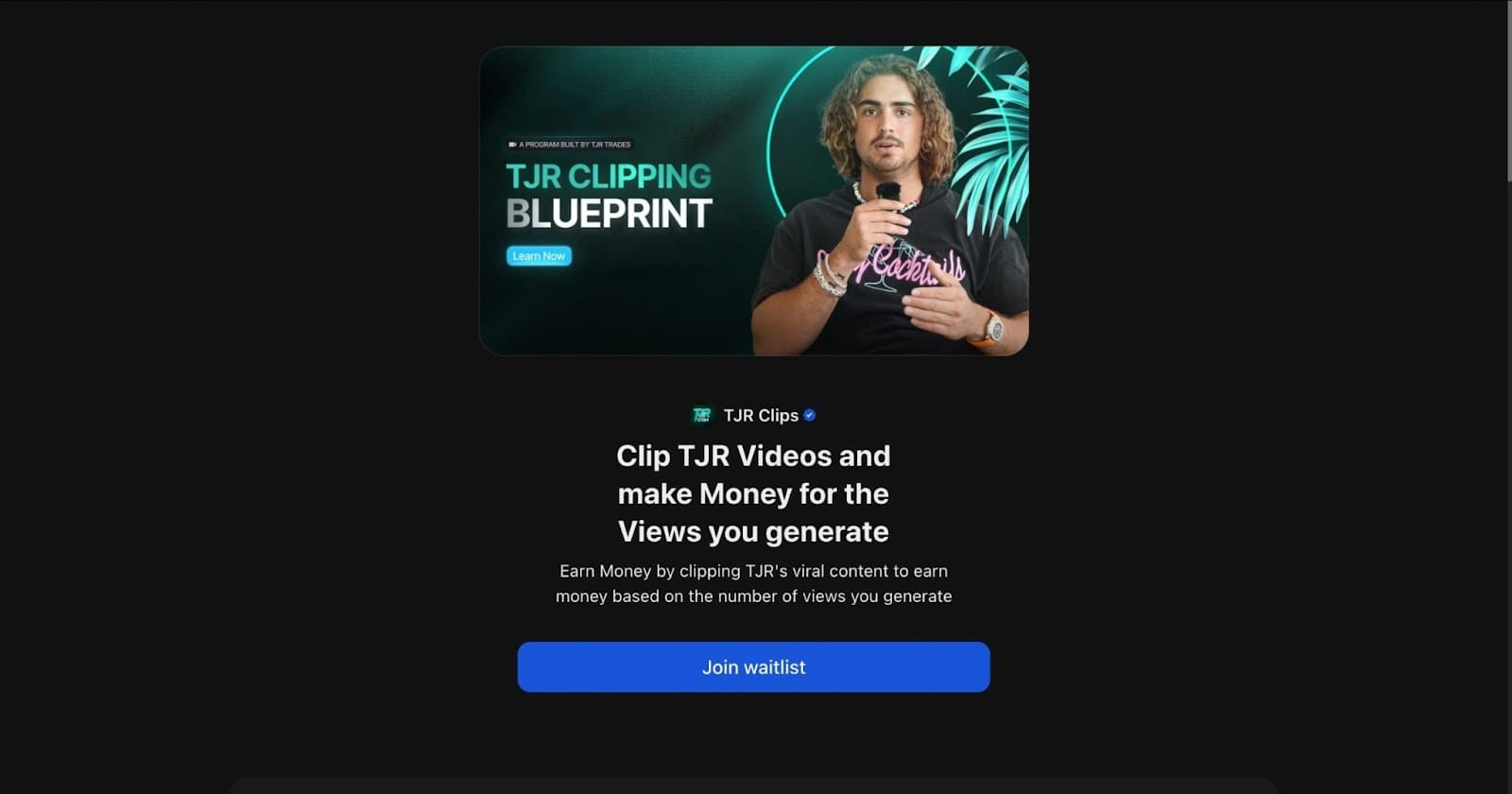
How to start: Prove your edge with content, case studies, or results. Package the education into a course, community, or signal group. Sell it through Whop.
Investment cost: Between $0 and $500, depending on tools, platforms, and proof-building.
Earning potential: $5,000 to $100,000 per month, depending on your model and reach.
9. License something you built
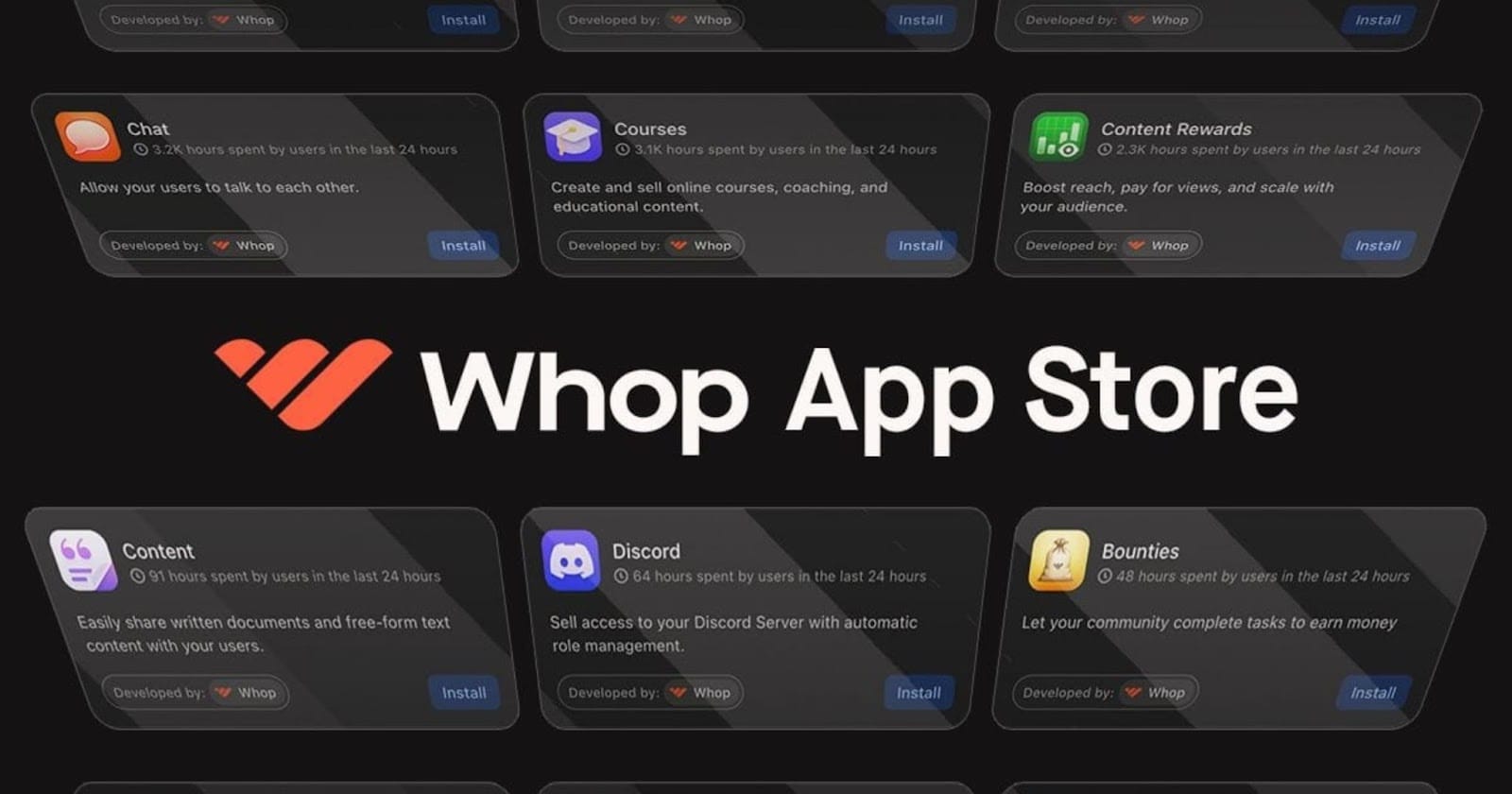
Not everything has to be sold directly.
Sometimes, you just make something cool, like a Chrome extension, app, widget, or software, and license it to people who need it.
It’s SaaS without the customer service headaches. You keep ownership and get paid for usage.
This is how a lot of quiet earners hit their first million. They build once, find a niche audience, and license it over and over.
Devs are going wild right now building niche tools for the Whop App Store. Build it once, choose from one-off payments or recurring commissions, and earn on repeat.
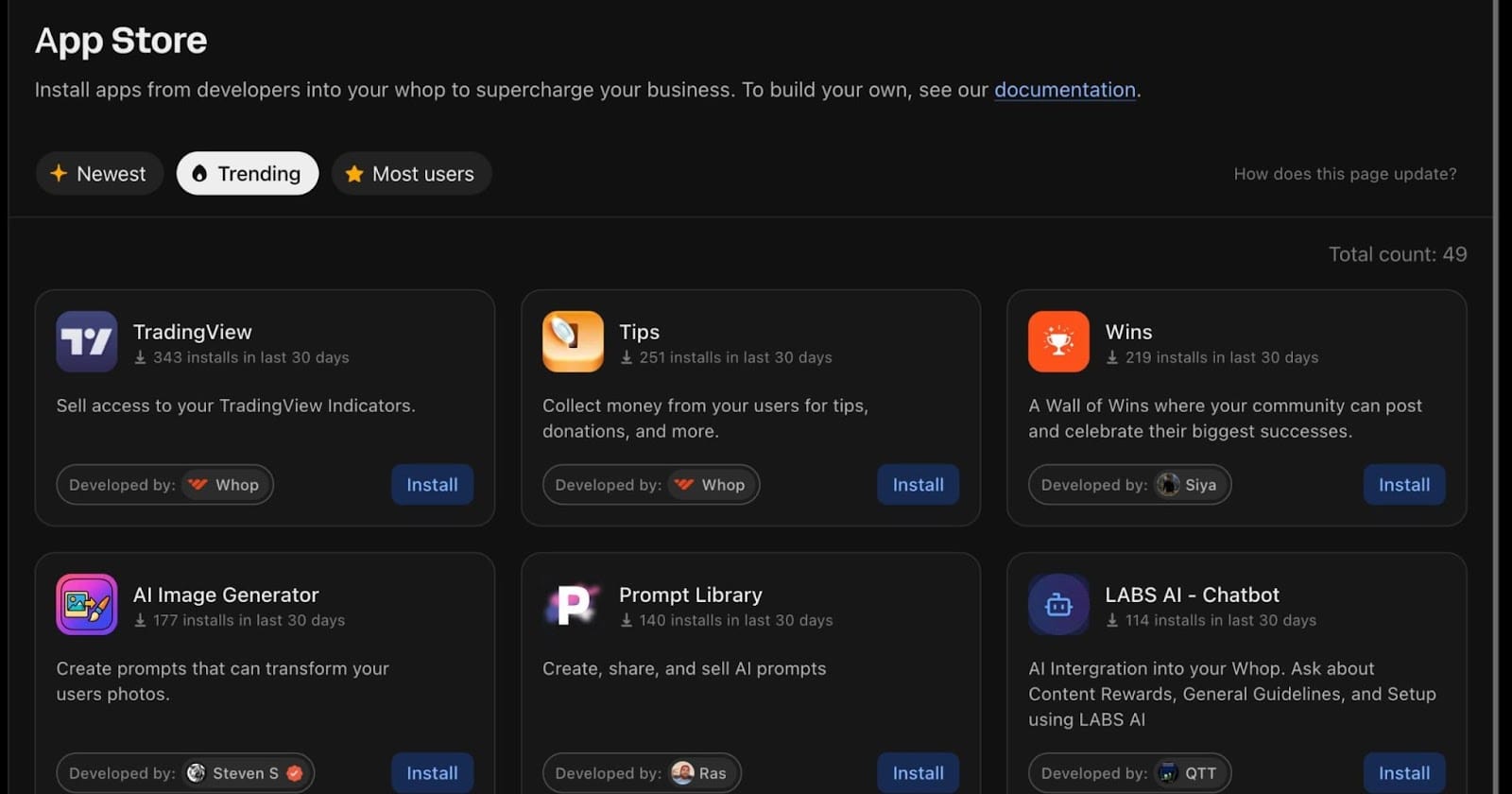
How to start: Build a simple tool with real utility. Set up a pricing model for licensing and sell access through Whop.
Investment cost: $500 to $5,000, depending on whether you build it yourself or outsource.
Earning potential: $1,000 to $30,000 per month, sometimes way more depending on scale and distribution.
10. Build an audience and monetize it
Attention is the most valuable currency online. When you have it, you can monetize however you want: digital products, affiliate deals, paid communities, brand partnerships, coaching, consulting. Literally, take your pick.
But the real winners aren’t just creators. They’re founders with distribution. They build once, sell forever, and use content to keep the machine running.
The key is to start posting with intent, not just vibes. One good audience unlocks five different income streams, all plugged into a Whop store.
How to start: Pick a platform, get loud, and post with a purpose. Build trust, build proof, and funnel attention into your products on Whop.
Investment cost: Free if you’ve already got a phone and an opinion. Budget a few hundred if you’re outsourcing content.
Earning potential: $1,000 to $100,000 per month, depending on audience size, offer quality, and platform mix.
Your first million isn’t from luck, it’s from leverage
Making big money isn’t about working harder or grinding blindly.
It’s about using leverage: putting your time, skills, and energy into moves that multiply results.
For some, that means having digital products selling 24/7. For others, it’s creating content that draws in buyers, or using marketplaces like Whop to handle the headache of sales while you focus on creation.
Millionaires bet on strategic risk over blind hustle. They launch fast, learn fast, and reinvent when they hit plateaus instead of spinning their wheels.
Staying lean and reinvesting in the skills and channels that actually move the needle is what separates the million-dollar earners from the side hustlers.
Speaking to you about making your first million dollars, Cameron Zoub – co-founder of Whop – says this:
As of June 2025, 258 people have made over a million dollars on Whop since we started about four years ago — and the top person has made $25 million. You can absolutely make a million dollars on Whop.
But here’s what I recommend: start with something you’re passionate about. Even if it’s a free whop to begin with, just focus on getting people in.
I think a lot of people try to hit a million too fast — they’ve got this fake target in their head that’s not grounded. Instead, build something you’re excited about, launch your whop, and get people to join for free.
If they’re spending time there and enjoying it, charge $10. Then $100. Then $1,000. That’s how you grow it.
Mistakes that delay your first million
Before you start chasing that million, let’s get real about what trips most people up. These are the mistakes that kill momentum and keep you stuck way longer than necessary:
Waiting to feel ready
Here’s the truth: you probably never will.
Waiting for the perfect moment or perfect product just traps you in endless prep mode. The only way forward? Launch anyway, learn on the fly, and improve as you go.
From Reddit, a comment on making your first million from u/fatkidstolehome sums it up:
“I faced a lot of rejection because failure was more painful. I took profits and used them to grow. Once I got stable, I risked going higher.”
Building without selling
If no one’s buying what you’re making, congratulations! You’re running a hobby, not a business.
Real success means putting your offer in front of customers and closing sales, even if it’s messy at first.
Thinking too small
FFS, think bigger! Stop undervaluing yourself and your skills. Charge what you deserve, aim for buyers who can pay, and scale accordingly. Playing it safe won’t get you to a million.
Ignoring leverage
There’s that magic word again!
You don’t have to do everything yourself. Use marketplaces like Whop to handle payments and distribution, run paid ads to reach new customers, and tap into content rewards programs to incentivize creators and spread your reach.
Working smarter beats working harder, every time.
Skip low-balling side hustles and make your first million with Whop
Want to make a million? Use the app built by hustlers just like you.
Whop helps you skip the rookie mistakes that slow down most creators. You don’t need a massive following or a ton of VC cash to hit your first million. You don’t even need a groundbreaking, never-before-seen idea.
What really matters is having a product (or a skill you can turn into one), a reliable platform to sell it on (Whop), and a strategy to sell, test, improve, and scale over time.
Making your first million isn’t some lightning strike of luck or magic. It’s about using leverage, strategy, and action. We can help you cut through the noise and get there faster. So why wait?
Create your whop today, launch your first product, and take the first step towards a million dollars.
FAQs: Making your first million
How to make a million dollars in a year?
To make a million in a year, you’ll need to earn roughly $83,000/month, or $2,740/day. It’s not impossible, but it requires serious leverage — think scalable digital products, subscription models, SaaS, or high-ticket services.
You’re not just selling once — you’re selling at scale. Focus on product-market fit, distribution, and a platform like Whop to move fast and automate the grind.
How to make a million dollars in 30 days?
Realistically? You’ll need a huge audience, a viral launch, or an offer that already converts like crazy. Most people don’t hit $1M in 30 days without existing leverage like a massive email list, a high-ticket cohort, or a one-time product drop to a primed audience.
The good news? You can build the foundation now, and get there faster than you think.
How to make a million dollars fast?
Fast depends on your setup. If you’ve got a killer skill or product, and a way to distribute it at scale (audience, ads, influencers), you can hit big numbers quickly.
But most fast money comes from stacking smart moves: build, test, sell, refine. The key is repeatable value and systems that don’t rely on your time alone.
How hard is it to make a million dollars?
It’s hard — but not because it’s out of reach. It’s hard because it requires consistency, not just creativity. The biggest roadblock? Most people quit too early or never ship at all. But with the right mindset, platform, and offers, it becomes a game of iteration, not a gamble.
Can you really make a million dollars with digital products?
Yes. Templates, guides, courses, memberships, SaaS tools — people are hitting six and seven figures by packaging knowledge into sellable assets and scaling distribution.
How long does it take to make your first million?
Anywhere from 6 months to 5+ years. The average is closer to 2–3 years if you’re consistent. It depends on your offer, your traffic, and how fast you learn and iterate.
Do I need a big audience to make a million?
Nope. You need the right audience. A niche group of 1,000 true fans can generate $1M if your offer is valuable and priced smart. Distribution helps—but offer quality wins.
What’s the best platform to sell my products or services
Whop. You can launch fast, sell anything from ebooks to coaching, and scale with subscriptions, automation, and built-in payments. It’s your one-stop digital storefront.



